The idea that there are more than 10,000 examples of the sixth-generation Ford Fiesta on Malaysian roads is staggering, particularly for someone who bought into the brand well before it was considered swanky to do so. While Japanese car owners won’t understand what’s mind-boggling about that, the out-in-left-field enthusiast who went with something like the second-gen C307 Ford Focus will. Because it wasn’t that long ago that being seen with a Blue Oval wasn’t fashionable, to put it simply. Being different, yes. In vogue, no.
Being chic in a Ford last happened in the ’80s, when the Laser S and TX3s were very much “in” and cult vehicles. Somewhere along the way, the bean counters committed what would best be termed malfeasance with a series of poor model selections, effectively committing the brand to a slow, progressive downfall (and becoming a Ranger-trick pony) it never recovered from until three years ago.
The Focus never did the job, despite its credentials. The first-gen C170 may have been sterling, but with too few examples (150 or so) and being too niche (manual) it never got things going. The second-gen fared better, but again never became a volume seller. The current third-gen C346 aims to go further, but it isn’t the magic bullet for the brand, or its volume seller.
The arrival of the Fiesta Mk6 changed all that. This then is the vehicle responsible for putting the brand back on to a decent perch; after all, 10,000 examples since it made its debut in late 2010 isn’t a small matter, considering the state of affairs pre-2010. Of course, three years on, it’s the turn of the facelift to continue lighting up the trail.
When it first arrived here, the B299 Fiesta, which made its market debut in late 2008, did so by bringing lots of appeal – its contemporary looks gave it allure, and good drive dynamics made it winsome, as did its competitive price and its high-ish levels of equipment specification (dual-clutch transmission, ESP, and in late pre-facelift examples, seven airbags in the sedan and special edition hatches, among other bits).
It wasn’t perfect, and I’ll get to the flaws later on, but it had charm, so much so I bought one in 2011 to replace a first-gen Focus I’d been running for six years (see what I meant now by staggering, at the start?). And so it is that this preview drive report will explore both old and new AAT Rayong-made examples in closer fashion than would otherwise be normal. Plus, since there’s no official launch for the car, it’ll even double up as a launch report.
The facelifted car debuts here in similar five-door hatch and sedan forms as seen previously, with Sport and Titanium suffixes to denote the body-styles. The first item to cover is the external revisions. Not many changes with the facelift, first seen at a Go Further event in Amsterdam in September last year, and which made its ASEAN debut at the Bangkok Motor Show back in March this year.
The front end has been revised, with a new bumper and the by-now familiar Aston Martin-like grille taking centre stage, and there’s also a fresh bonnet – complete with a power dome – and new design headlamps slapped on. The grille is one of those love-it-or-hate-it bits; opinion here among the team is quite divided by it. Danny likes it, I don’t – I think the face of the original is far better integrated and looks more organic.
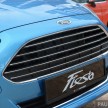


No changes to the headlamp configuration, despite the reworked styling – the unit is still a twin-chamber, halogen complex surface reflector type, with no DRLs present. At the back, the tail light assembly gets a new design, and in the case of the sedan, there are more bits of chrome to be found on the facelift. In terms of dimensions, the facelift variants are a shade longer than their predecessors – 3,982 mm for the hatch (old, 3,950 mm) and 4,323 mm for the sedan (old, 4,291 mm).
Both facelifted sedan and hatch wear identical 16-inch wheels, in this case a 15-spoke design that is similar in styling to the 15-inch unit seen on the pre-facelift sedan. Shape-wise, I do think the old hatchback’s five twin-spoke design is easier on the eye, and keeps better to the Sport theme. The tyre choice remains the same as that found on the outgoing hatch – 195/50 series Continental ContiPremiumContact 2s equip both variants, with the spare being a 175/65 unit, mounted on a steel-wheel.
Inside the car, cosmetic changes include new seat fabric material, these being a partial fabric/leather combination in black for the Sport hatch and full leather in light grey for the Titanium sedan. The dashboard and general cabin layout remains the same, though the entire presentation has been refined (visually, if not to the touch).
The old Fiesta’s cheap-looking silver for the trim panels is gone – the inserts on the entire centre console stack and cover for the door grab-handle are now in gloss black, and a satin black finish now dresses the instrument binnacle housing, with a chrome accent framing the outline. Silver is still used for the steering wheel boss accent, but presented in a far sleeker polished metal look; the interior door handle is also now finished in the same shade (previously, bare plastic).



A word about the front door cards – the European Fiesta facelift features a reworked grab handle position and layout for the door window/side mirror adjustment buttons, which looks a significant improvement ergonomically. The Thai-made facelift, however, retains the old door cards; the cost of retooling surely omitted them, but it’d have been nice to see the new panels make their way on here.
Meanwhile, the metering for the instrument panel has also been revised, and the small central display now reads the entire gear selector range (P, R, N, D, S), encapsulating the chosen position when in that particular gear (previously, only the particular position selected).
Elsewhere, all display lettering is now presented in a shade called Ice Blue, replacing the orange found in the outgoing car, and the instrument dial needles are likewise in blue (previously, red). The central stack-mounted display remains in monochrome, and no alterations to the six-speaker audio system.
New though is Ford SYNC, the brand’s in-car connectivity system that connects mobile devices to the car via Bluetooth or USB. Also on, an EcoMode software application that measures your driving patterns and awards you kudos in the form of leaf-icons displayed on screen.



Other new equipment and features found on the facelift is a single-zone, fully-automatic climate control unit, automatic headlamps (with a new selector position on the far right of the light switch), a rain sensor/auto wiper system, full keyless entry and push-button start, all fitted as standard for both variants.
There’s also Smart Regenerative Charging, which whenever possible has the alternator charging the battery during braking or decelerating. Still no cruise control to be found, but the new kit and slightly more polished overview is a welcome sight.
The main mechanical change is with a switch in engine displacement for the debutant – the new Fiesta is still equipped with a Duratec Twin Independent Variable Camshaft Timing mill from the Sigma family, but is now 1,499 cc in capacity compared to the previous car’s 1,596 cc.
First seen in the Thai-market pre-facelift Fiesta last year, the revised displacement mill came about as a means to get the car compliant with the Kingdom’s first-car progamme, which allowed first-time car buyers to deduct excise tax paid for the purchase of the car from their personal income tax. The scheme is over, but the revised mill is very much here to stay.
The 1.5 litre Ti-VCT develops 112 PS at 6,300 rpm and 140 Nm at 4,400 rpm. Conversely, the outgoing 1.6 Ti-VCT offers 120 PS at 6,000 rpm and 152 Nm at 4,050 rpm, an eight PS and 12 Nm difference in output – marginal, but vis-a-vis there are some performance differences, notably in low-to-midband acceleration aspects.
There’s a bit less punch here if you jump directly from the 1.6 to it, less obvious on its own. This despite the 1.5 actually having a marginally lighter kerb weight, at 1,125 kg for the 1.5 Sport hatch to the 1.6 Sport hatch’s 1,153 kg; the new Titanium sedan is also lighter, at 1,141 kg.
It’s higher revving at intermediate speeds though. Cruising along, the 1.6 litre unit ticks at around 2,100 rpm at 90 km/h constant – the 1.5 litre, as noticed during the brief preview drive, did the same at around 2,300-2,400 rpm. Not much of a chance to push it speed-wise during the drive, but the 1.5 Sport was taken into 170 km/h, with just the final quarter being a bit puffy (the 1.6 does the same).
Another quick aside, this on the perceived exhaust note for the Sport – don’t think that there has been any revisions to the configuration, but hopping back into the 1.6 brought about a deeper, more resonant note to my ears compared to that on the brand-new 1.5s. Might be that two and a half years in, the 1.6′s suppression bits inside the muffler are going; the mileage is low though, with just 24,200 km clocked in 30 months.
As for drivetrain, the familiar six-speed, dual-clutch PowerShift transmission continues on, with gear ratios and final drive unchanged from before. A Sport operation mode is now available, replacing the the Low gear shift position in the old car, and the gear position markers (P, R, N, D), previously on the left of the shifter are now correctly oriented to the right, facing the driver .
There’s finally a manual override, available through SelectShift buttons located on the gearknob, as first seen on the third-gen Focus. Aside from the different gear knob, the shifter column itself has also been revised, sitting taller than in the old Fiesta.
The manual-mode is something that should have been there in the first place. At the Thai drive for the pre-facelift Fiesta back in 2010, I remember asking why there a manual-mode shifter wasn’t included. The straight-laced answer – which Danny was also given – from Stefan Muenzinger, head of vehicle integration for B-cars at Ford Asia Pacific was that “it’s a gimmick. We find that most people don’t use it.” Well, the gimmick is here, now.
It’s certainly a most usable and welcome one, truth be told, and this is something all Fiesta 1.6 owners will comprehend. The Getrag 6DCT250 dry-clutch unit does well enough once you’re moving, but its low-speed performance aspects is something that takes getting used to.
Tetchy would best describe it, primarily in first and second gear – transitions between can get clunky, especially from cold, and definitely perceptible in slow moving traffic conditions where it keeps shifting up and down between these two ratios. Gentle on the throttle helps, but in an ‘ease on, ease off and ease on again’ situation the characteristics more often than not rears its ugly head.
Not having a manual override means there’s nothing you can do about it. The SelectShift curtails the jumpy behaviour, because you can keep it in a particular gear of choice, albeit with it shifting down to first if you come to a stop. Still, it’s a boon to have, when the alternative is none.
Actually, even without engaging SelectShift operation, the 6DCT250 on the 1.5 felt more cohesive, the result of improved TCU programming, perhaps? Operation-wise, manual shifts via SelectShift were clean and smooth during the short drive – the transitions in automatic changes (up, once a ratio hits a redline threshold, and down as speed is noticeably trimmed) were likewise unfettered. Nonetheless, I for one can’t wait for the likes of the 6DCT150 wet-clutch six-speeder ‘box to appear in Asian markets.
Nothing much to report handling-wise – aside from new bump stops for the front suspension to help improve cushioning performance over large bumps, the suspension geometry continues as is; the hatch, with its ‘sport tune’ suspension, pretty much rides and handles like the old does.
Likewise the brakes, which retains its front disc/rear drum configuration, which work well enough in day-to-day use. I initially thought the pedal feel on the 1.5 Sport felt a bit soft, but quickly realised how much the stainless-steel braided brake hoses I’d slapped on to the 1.6 had tightened up both feel and modulation aspects.
Safety kit, by and large, continues as before, and on the list are Electronic Stability Programme (ESP), traction control, ABS with EBD, emergency brake assist, rear Isofix mounts and hill launch assist (which Ford says has been refined) as seen in the outgoing model. By and large, because as airbags go, the facelift features two, and it doesn’t matter which body-style you choose.
The omission of the Safety Pack and its seven airbags is surely to be a source of contention, especially since the outgoing Fiesta LX sedan introduced it in 2011, and the limited-run Beta and XTR hatches as well as the last run of 1.4 LX manuals had it too.
In ticking the boxes with a view of working to a price point, the inclusion of auto AC, auto headlamps/wipers, keyless entry and push-button start as a package (the entire kit is bagged as an optional Sport Executive Pack for the Australian market) looks like it has been chosen ahead of the Safety Pack. Then again, the best-selling version of the pre-facelift Fiesta was the Sport hatch, and that had two bags, so maybe the marketers know what they’re doing.
Finally, exterior colours, and Black Mica has been removed altogether from the palette for both body-styles. For the hatch, there are five shades. Chilli Orange, Metropolitan Gray and True Red have been retained, while Arctic White replaces Cool White and the new signature colour, Celestial Blue, replaces Aurora Blue in the lineup. For the sedan, four colours are available, these being Met Grey, Highlight Silver, Arctic White and True Red.
Until the 120 PS and 170 Nm three-cylinder turbocharged 1.0 litre EcoBoost variant debuts (it’s likely to make its Malaysian premiere at the KLIMS 2013 in November, and begin selling sometime early next year), the 1.5 litre Ti-VCT Sport and Titanium will hold court, and both make their market debut at an introductory price of RM86,988, on-the-road with insurance.
On the whole, the Fiesta facelift in its 1.5 litre guise remains a competitive package, despite the competition having shored up in the three years since it made its debut. The engine downsizing and lack of airbags may take away some of the gloss, but Ford is hoping that the added kit/features and improved interior polish will offset that. Personally, aside from the idiosyncrasies of the Getrag box, I’ve quite enjoyed my time with the little B-segmenter.
The real adventure for the revised B299, however, will begin when the 1.0 EcoBoost gets here. If that’s priced right, the Mk6 should be looking at another very good run down the road before time is called on it. Now, do we hear calls for the five-speed manual transmission then?
Read Danny’s drive report on the pre-facelift Fiesta from 2010 here.




























































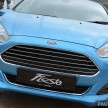














The post DRIVEN: Ford Fiesta facelift – 1.5 Ti-VCT sampled appeared first on Paul Tan's Automotive News.
via Paul Tan's Automotive News http://paultan.org/2013/09/23/driven-ford-fiesta-1-5-sport-facelift-sampled/
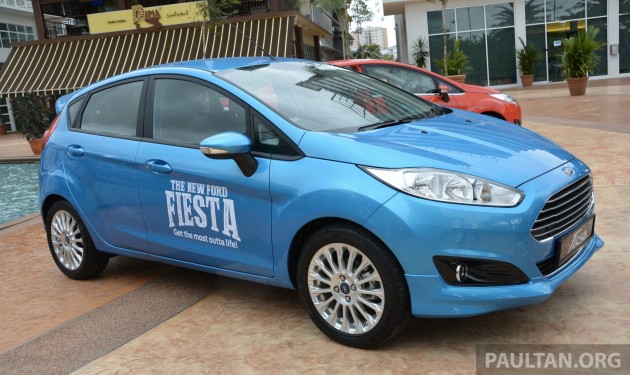
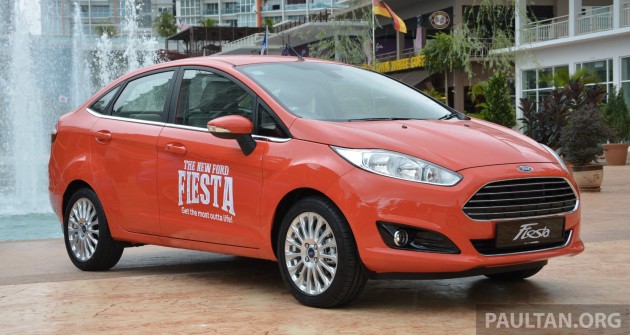
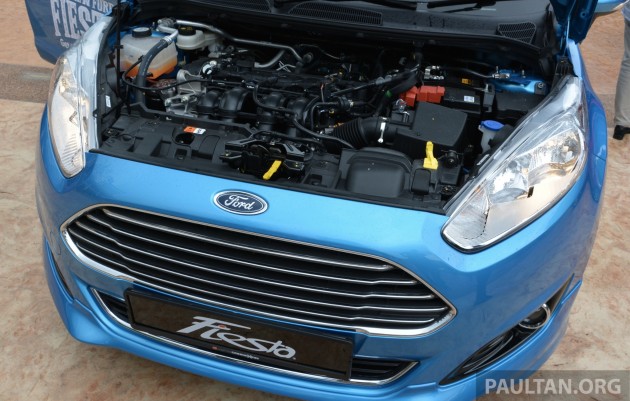
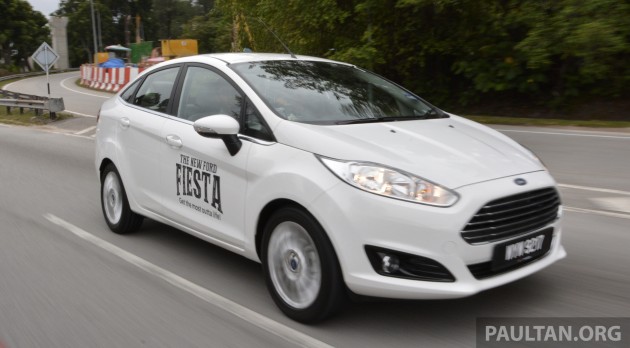
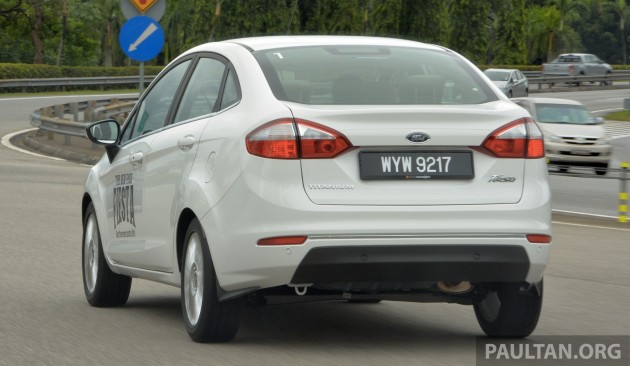
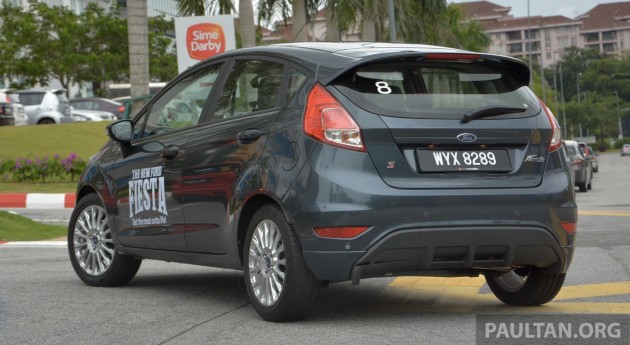
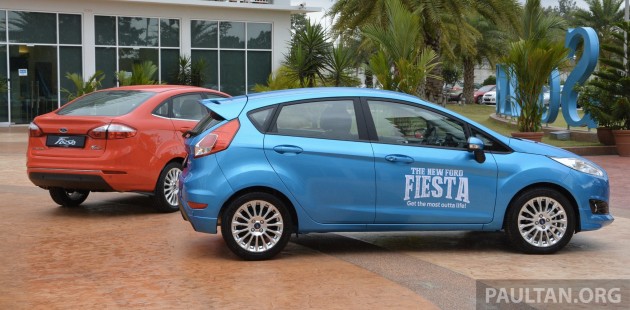
No comments:
Post a Comment